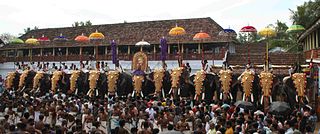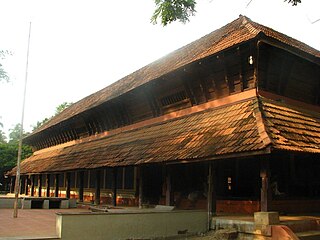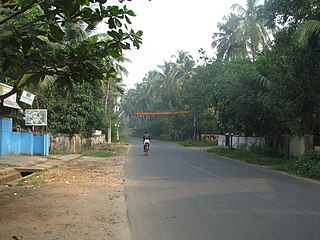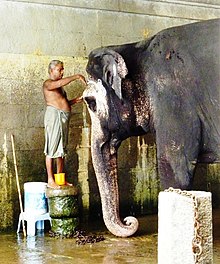
The ThrissurPooram is an annual Hindu temple festival held in Thrissur, Kerala, India. It is held at the Vadakkunnathan (Shiva) Temple in Thrissur every year on the Pooram day—the day when the moon rises with the Pooram star in the Malayalam Calendar month of Medam. It is the largest and most famous of all poorams in India. Thrissur pooram is also one of the largest festivals in Asia with more than 1 million visitors.

Guruvayur is a municipal temple town in Thrissur District, of Kerala State in India. It is a suburban town of Thrissur city, located 27 kilometres (17 mi) from Thrissur towards the north-west. It houses the Guruvayur Shri Krishna Temple. It is located at a distance of 292 km (181 mi) from the state capital Trivandrum towards the north-west, 80 km (50 mi) from Kochi towards the north, 90 km (56 mi) from Calicut towards south.

The Guruvayur Temple is a Hindu temple dedicated to Guruvayurappan, a form of Krishna, located in the town of Guruvayur in Kerala, India. It is one of the most important places of worship for Hindus in Kerala and Tamil Nadu and is often referred to as Bhuloka Vaikuntha.

Thrippunithura or Tripunithura, is a prominent historical and residential region in the City of Kochi in Kerala, India. Located about 7 km (4 mi) from the city centre, Tripunithura was the capital of the erstwhile Kingdom of Cochin. The descendants of the Cochin royal family still live in the palaces here. The Hill Palace situated in Tripunithura was the palace of Maharaja of Cochin, the ruler of Kingdom of Cochin. Tripunithura is also well known for its historical cultures which includes the annual festival Vrishchikoltsawam that takes place at the Sree Poornathrayeesa Temple.

Elephants found in Kerala, the Indian elephants, are one of three recognized subspecies of the Asian elephant. Since 1986, Asian elephants have been listed as endangered by IUCN as the population has declined by at least 50% over the last three generations, estimated to be 25,600 to 32,750 in the wild. The species is pre-eminently threatened by habitat loss, degradation and fragmentation. Along with a large population of wild elephants, Kerala has more than seven hundred captive elephants. Most of them are owned by temples and individuals. They are used for religious ceremonies in and around the temples, and some churches, and a few elephants work at timber yards.

Sree Poornathrayesa temple is a Hindu temple situated in Tripunithura, Kochi, the capital of the former Kingdom of Cochin, Kerala, India. The temple is considered among the greatest temples in Kerala and was the first among eight royal temples of the erstwhile Kochi Kingdom. The deity was also considered the national deity of Cochin and protector guardian of Tripunithura. The deity in this temple is Lord Vishnu, who is in the form of Santhanagopala Murthy. Lord Poornathrayeesa is known for his love of elephants. Hence more than 40 elephants participate in his Vrishchikotsavam. And most of the elephants are sent for the utsavam (festival) without a money return expected by the elephant owners as Poornathrayeesa is considered to be an elephant lover.

Panchari Melam is a percussion ensemble, performed during temple festivals in Kerala, India. Panchari Melam, is one of the major forms of Chenda Melam, and is the best-known and most popular in the kshetram vadyam genre. Panchari Melam, comprising instruments like Chenda, Ilathalam, Kombu and Kuzhal, is performed during many temple festivals in central Kerala, where it is presented in arguably the most classical manner. Panchari is also traditionally performed, albeit with a touch of subtle regional difference, in north Kerala (Malabar) and south-central Kerala (Kochi). Of late, its charm has led to its performance even in temples in Kerala's deep south.

Cherpu is a suburb of Thrissur city in the Kerala State of South India. It is 12 kilometres south of Thrissur town and is on the Thriprayar road. It is dotted by a number of temples and has quite a few rivers flowing by its vicinity.

Punnathurkotta is a fort and former palace located in Kottapadi, about 3 km from the Guruvayoor Sree Krishna Temple, in Thrissur District of Kerala State in South India.

A caparison is a cloth covering laid over a horse or other animal for protection and decoration. In modern times, they are used mainly in parades and for historical reenactments. A similar term is horse-trapper. The word is derived from the Latin caparo, meaning a cape.

Chavakkad, formerly Chowghat, is a municipality in Thrissur district of Kerala state in India. It is a suburban town of Thrissur city. Chavakkad is noted for its beach and fishing. It lies on National Highway 66 is located about 75 km (47 mi) north of the city of Kochi, 25 km (16 mi) northwest of Thrissur, and 24 km (15 mi) south of Ponnani.

Kottapadi is a village near Guruvayur town in the district of Thrissur, Kerala, South India. Kottapadi literally translates to Gates to Fort. Kottapadi has now gained prominence Punnathurkotta for which it has been named, which used to house elephants belonging to the Guruvayoor temple. Elephants that are an integral part of certain temple rituals are boarded and trained here.

Nattika is a small village in Thrissur district of Kerala state, South India. It is centrally located about 25 km from Thrissur, Kodungallur, Irinjalakuda, Chavakkad, Kunnamkulam and Guruvayur. Nattika is beside the Arabian Sea. There is a beach in this village called Nattika Beach. Nattika Beach was previously known as Attakuzhi Bandhar Kadapuram. Nattika is on the west coast of Thrissur. Conolly Canal is the eastern border of Nattika. There is a private bus stand in Thriprayar. Nattika is 60 km away from Cochin International Airport and 25 km away from Thrissur railway station. Modern transportation and better communication facilities are available in the village. This is an assembly constituency.
The Cherai Gowreeshwara Temple is one of the main Hindu temples in Kerala State of South India. This temple is situated in the village of Cherai in the picturesque Vypeen island, sandwiched between the Arabian sea and the beautiful backwaters of Cochin. The temple is maintained by Vijnana Vardhini Sabha. This is the only temple in Asia that has a chathurmukha kovil. It is also known as Malayala Palani after the famous Subramanya Temple in Tamil Nadu. The main deity facing east is Subrahmanyan, but the temple is dedicated to the deity facing west, Sree Gowreeswaran or Lord Siva, one of the trinity of Gods in Hinduism and father of Subrahmanyan. The other deities are Parvathy, Siva's consort, and Ganapathy, the elder son, completing the family quartet of Lord Siva. The Gowreeshwara Temple festival is one of the main festivals in the Ernakulam district. The festival is conducted every year towards the end of January or early February. The main attractions are the Kavadi Utsavam in honor of the deity, Subramanian, and the Pooram, a magnificent display of caparisoned elephants, usually 25 to 30 in number. The temple was established by Sree Narayana Guru, saint and social reformer of Kerala, who fought against caste oppression and other social evils prevalent till the early twentieth century. The temple, right from its inception, was open to people of all castes and religions and is a living symbol of communal and religious harmony.

Kerala which is often referred to as 'God's Own Country' has many Hindu temples. Many of the temples have unique traditions and most hold festivals on specific days of the year. Temple festivals usually continue for a number of days. A common characteristic of these festivals is the hoisting of a holy flag which is then brought down only on the final day of the festival. The largest festival in kerala in Pooram category is Arattupuzha Pooram at Arattupuzha temple and in Ulsavam category is Vrishchikolsavam of Thripunithura Sree Poornathrayeesa Temple. Some festivals include the most famous of these being the Thrissur Pooram. Temples that can afford it will usually involve at least one richly caparisoned elephant as part of the festivities. The idol of the God in the temple is taken out on a procession around the countryside atop this elephant. When the procession visits homes around the temple, people will usually present rice, coconuts and other offerings to the God. Processions often include traditional music such as Panchari melam or Panchavadyam. The festivals of Kerala are famous around the Globe due to its diversity of experience.

Hinduism is the largest religion in Kerala and Hindu lineages together make up 54.8% of the population of the state according to the 2011 census.

Shoranur–Cochin Harbour section is a high density railway corridor in Kerala state, India, running from Shoranur Junction in Palakkad district through Thrissur district to Cochin in Ernakulam district. The Shoranur–Cochin Harbour section is strategic and the lifeline of Kerala economy that connects the state to other parts of India. It is central to the provision of fast, long-distance Intercity and Express passenger services between Kerala and other cities of India. It is operated by Thiruvananthapuram railway division of the Southern Railway zone.

Uthralikkavu Pooram (ഉത്രാളിക്കാവ്) is a festival held at Shri Rudhiramahakalikav temple situated at Wadakkanchery in Thalappilly taluk of Thrissur district in Kerala, South India. The temple is famed for its Pooram festival held during February / March every year. It is considered as the second highest crowded pooram after Thrissur Pooram

Pepita Seth is a British-born writer and photographer, known for her accounts of the temple arts and rituals of Kerala and her photographs of the widely celebrated captive elephant, Guruvayur Keshavan. The Government of India honoured her, in 2012, with the Padma Shri, the fourth highest civilian award, for her services to the field of art and culture.
Gods in Shackles is a 2016 Indian investigative drama feature-length documentary film written, directed and executive produced by Sangita Iyer on her documentary directorial debut. The documentary is based on the captive elephants in Kerala culture and inspired by the filmmaker's own personal experience witnessing the torture and suffering faced by the temple elephants during cultural festivals. The documentary was screened at the Legislative Assembly of Kerala on 21 May 2016 following a suggestion by speaker P. Sreeramakrishnan, who formally approved the release.























